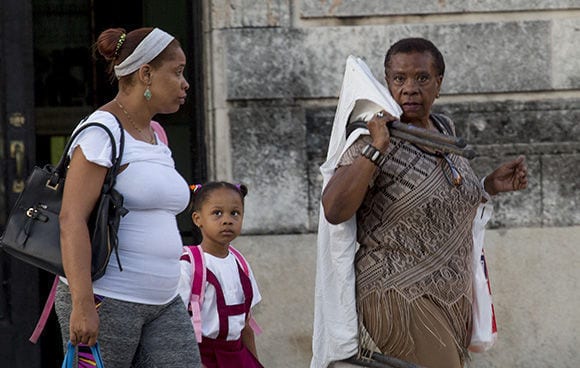A Jubilant Return to School Throughout Cuba
By Elio Delgado Legon

HAVANA TIMES – Cuba’s 2018-2019 academic year began on Monday September 3rd. I hadn’t thought about writing this article, as it’s the same or similar scenes can be seen all over the country every year, and I have never written about this because it is something natural in my eyes and something we have all assumed as an inherent part of our socialist society.
However, when I saw children rejoicing on their way to school, all of them in their uniforms, carrying their backpacks, many also carrying a small lunch box in their hand, I was reminded of when I first started at primary school. I was already seven years old, without a uniform or backpack, at a half-ramshackle rural school, with old, half-broken desks and a teacher who had to travel 40 kms from the provincial capital because there weren’t any teachers in my municipality, or very few and they didn’t work in the countryside.
We didn’t have teachers because they had nowhere to go and study to become a teacher. To do this, they had to travel to the provincial capital, which was where the teacher training school was located, which had a limited number of teaching students because they would graduate at the end of the course and there weren’t any schools where they could work. This, because the state’s budget for education was very small. This is why when the Revolution triumphed in 1959, there were 10,000 teachers without work across the country, a country with an extremely high illiteracy rate.
Later, in second grade, I moved from that small rural school to the only school that existed in the municipal capital, where every grade had one teacher and one classroom, from 1st to 6th grade, but from 3rd to 6th grade, we had teachers for every subject instead. The thing I remember the most is that all of these teachers (with one or two exceptions) all came from the provincial capital, for the above-mentioned reason.
I remember that I had to walk three kms or so to get to school, while there was a stone school near my home with a spacious classroom and another place to store materials. The building also had a small apartment inside so that a teacher could live there.
That school had been built during Ramon Grau San Martin’s government, but the school had been closed down and abandoned for many years because there wasn’t any money to pay a teacher. It was in such a bad state that when I saw it for the first time, I had to make my way through a heap of marabu weed, whose branches had entered the school’s windows.
Right at the end of Carlos Prio Socarras’ term in office, before he was overthrown by the coup led by Fulgencio Batista, a budget was approved to pay a teacher who would come from the provincial capital. Of course, they had to clear a lot of marabu to make the school visible and accessible.
However, I continued to travel the 3 kms that separated me from school, without a backpack for my books or a lunch box because I didn’t have anything to snack on. We weren’t given a snack at school either. You had to buy it off an old man who used to come every day at recess and he would sit down in the yard with a box full of sweets and crackers for every taste and costing less than 2 cents. However, I almost never had a cent to buy a cracker from him. I would have to wait till the end of the school day when classes finished, walking 3 kms home to be able to eat a plate of cornflour.
This is why, today, when I saw children going to school all over the country, happy and with a smile on their faces, I thought about how there isn’t a single child in all of Cuba, no matter how remote their home is, who doesn’t have access to a school and a teacher. Thus, the only conclusion I can draw is that all of the sacrifice we have made for a socialist revolution has been well worth it.






If the point of Elio’s walk down memory lane is to point out the advances in Cuban education over the last 75+ years since his school days, what he writes should be no surprise. There are very few places on earth where education has not improved in this time frame. Well, maybe in Afghanistan or some remote village in sub-Saharan Africa. But access to schools is eminently more widespread today. To attribute advances in education in Cuba today solely to the Castros is to ignore the advances made in society as a whole. That would be like giving the Castros credit for the widespread use of cellphones in Cuba. Ironically, Elio chose to highlight the lack of a meal service during his school years. Anyone who knows Cuba knows the #1 or #2 complaint Cubans have about sending their children to elementary school in Cuba today is how awful the food at school is. So in 75+ years, Cuba has gone from NO food in schools to BAD food in schools. Listen, in all fairness, education genuinely is a net positive in Cuba as a result of the dictatorship. Elio would also do well to acknowledge the lack of computers in classrooms and other basic school supplies as well as crumbling infrastructure as the counterbalance to his yearning to wax poetic about improvements in education. Secondly, as I have commented before here on HT. Elio should simply stick to articles based on the Cuba of his youth. When he ventures into present-day Cuba, and worse yet, writes about anything political or otherwise outsidel of Cuba, he makes a fool of himself and the Cuban Ministry of Information that he works for.